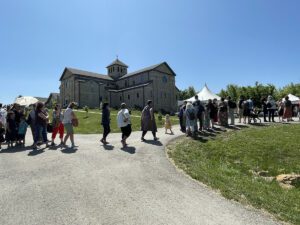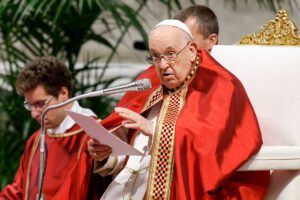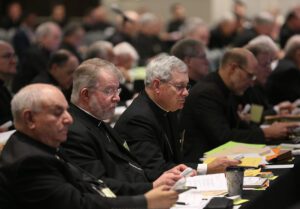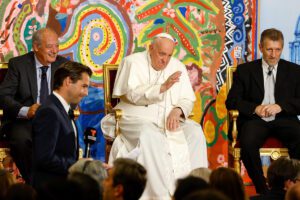WASHINGTON (OSV News) – Pope Francis has created the ecclesiastical province of Las Vegas, comprised of the Archdiocese of Las Vegas and the suffragan dioceses of Reno, Nevada, and Salt Lake City.
He also named Las Vegas Bishop George Leo Thomas to be the first metropolitan archbishop of Las Vegas. Archbishop Thomas, who turned 73 May 19, was appointed the third bishop of Las Vegas Feb. 28, 2018.
The establishment of the new province and the appointment of the metropolitan archbishop was publicized in Washington May 30 by Archbishop Christophe Pierre, apostolic nuncio to the United States.
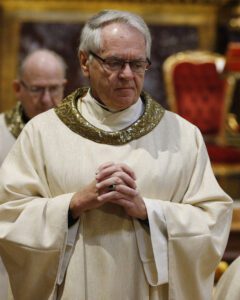
A metropolitan archbishop is the head of his archdiocese, and while he has no direct power of governance over the suffragan dioceses in his province, “through canon law, he supports them in matters of faith and discipline and provides fraternal pastoral care to his brother bishops,” said a news release from the U.S. Conference of Catholic Bishops.
“Las Vegas has been for me one of the most beautiful encounters, beautiful treasures I could have ever experienced,” Archbishop Thomas told reporters at a news briefing in Las Vegas about the creation of the ecclesiastical province, the elevation of the five-county diocese in southern Nevada to an archdiocese and his being named an archbishop.
He was joined at the briefing by Auxiliary Bishop Gregory W. Gordon of Las Vegas; Bishop Daniel H. Mueggenborg of Reno, Nevada; Bishop Oscar A. Solis of Salt Lake City; and retired Auxiliary Bishop Richard B. Higgins of the U.S. Archdiocese for the Military Services.
When Archbishop Thomas was named the third bishop of Las Vegas by Pope Francis in 2018, he had been the bishop of Helena, Montana, for 14 years. Before that, the Montana native was an auxiliary bishop of Seattle for four years.
He said that when he was named to Las Vegas, Archbishop Christophe Pierre, papal nuncio to the U.S., informed him of the appointment and also told him the Las Vegas Diocese had “grown too complex” to send a new bishop to be its shepherd.
By “complex,” he meant it had “a pronounced shortage of priests and seminarians, exponential growth of laity, and needed to build new parishes and establish new schools,” Archbishop Thomas recalled, adding that he told the nuncio: “The one thing I can do is bring wise and gifted people around a common table and we can solve anything.”
The creation of the ecclesiastical province of Las Vegas and elevation of the diocese to an archdiocese illustrate that “the dynamism of this local church, the vitality of the parishes and communities” has come “to the attention of the Holy See,” Archbishop Thomas said.
“I feel very grateful to the Holy See and certainly to Pope Francis, whom I love very deeply, but the honor and the glory belongs to the priests and to the lay faithful,” the archbishop said. “It is the people laboring out in the fields and in the communities who are really responsible for the dynamism of this archdiocese.”
“We are having exponential growth to be sure, and people receiving excellent pastoral care,” he said. “The fact we have now become an archdiocese is certainly a mark of approbation and approval of the Holy Father” and “most especially is a credit” to the laity, priests and religious.
Archbishop Thomas said he planned to go to Rome June 28 with pilgrims from the archdiocese and fellow clergy and that on June 29 he will receive the pallium from the pope.
The pallium is the woolen band that the heads of archdioceses wear around their shoulders over their Mass vestments. It symbolizes an archbishop’s unity with the pope and his authority and responsibility to care for the flock the pope entrusted to him.
“I’m told I’m the only American receiving it this year,” Archbishop Thompson said, adding that Archbishop Pierre will place it over his shoulders in Las Vegas Oct. 2, the feast of the Guardian Angela, during a major celebration at the Shrine of the Most Holy Redeemer that will formally establish Las Vegas as an archdiocese.
In his remarks at the briefing, Bishop Gordon said that the pope’s creation of the new province and elevation of the diocese to archdiocese is “a reflection at this moment of the tremendous growth” of the church and Nevada itself in terms of population, hotels and sports arenas but also in terms “of the spiritual, as evidenced by the increase in the number of baptisms, parishes, schools and other apostolates.
But “this moment” also is certainly a reflection of the pope’s confidence in the spiritual leadership of Archbishop Thomas, who “is always thanking us for all the work we (do) but we know the truth, that work would not be done if it weren’t for the fact the shepherd is so active and so engaged,” Bishop Gordon said. “We thank you for all you’ve done these past five years in our new archdiocese. … We look forward to working with you in your pastoral ministry in this archdiocese for many, many years to come.”
Bishop Gordon said the first inquiries into the possibility of Las Vegas becoming an archdiocese and an ecclesiastical province being created for Nevada and Utah go back to the creation of the Las Vegas Diocese in 1995.
“(There are) decades of growth, decades of censuses showing how Nevada and Utah lead the nation as among the fastest growing states,” Bishop Gordon said, noting that Nevada’s five southern counties making up the new archdiocese alone have over 750,000 Catholics.
In 1995, St. John Paul II divided what was the Diocese of Reno-Las Vegas into the Diocese of Reno and the Diocese of Las Vegas. The Diocese of Reno was first established March 27, 1931, and then redesignated as the Diocese of Reno-Las Vegas Oct. 13, 1976.
The statewide Diocese of Salt Lake was formed in 1891 from the Vicariate of Utah and Eastern Nevada. In 1951, the Vatican renamed it the Diocese of Salt Lake City.
Before May 30, the dioceses of Reno, Las Vegas and Salt Lake City were suffragan dioceses of the metropolitan Archdiocese of San Francisco.
Bishop Mueggenborg, who has headed the Reno Diocese since 2021, said at the briefing that he met the May 30 announcement about Las Vegas “with great joy and profound gratitude.”
“I extend my heartfelt congratulations to you, Archbishop Thomas, and the archdiocese. This is a significant milestone and it marks a new chapter in the life of the church especially here in Nevada but in the entire Great Basin of the United States. It reflects not only the spiritual growth but also the dedication that has taken root here the last 28 years.”
Bishop Solis, who has been Salt Lake City’s bishop since 2017, called it “a great honor and privilege to join you in this milestone in celebration of God’s blessing to this local church here in Nevada.”
He extended his diocese’s and state’s “warmest congratulations for this wonderful moment in the history of the local church of Las Vegas.”
“Nothing happens by accident,” Bishop Solis said. “It is always the movement of the Holy Spirit that inspires priests, religious men and women, as well as the laity, to build a vibrant church in joy and gratitude.”

